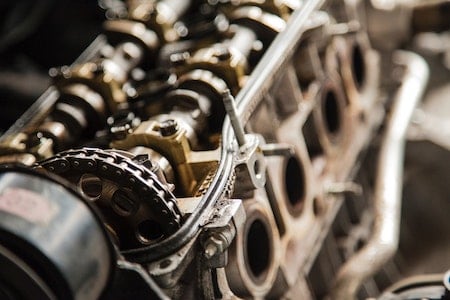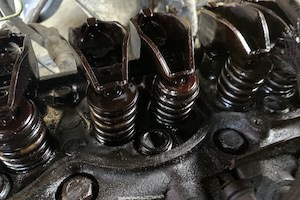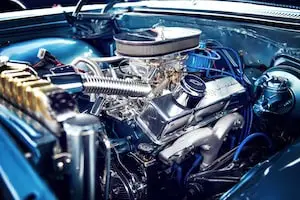I have personally changed both timing belts and timing chains in several different models of cars, and this experience stirred some curiosity in me to find the REAL reason why cars use timing belts rather than timing chains. I find a wide variety of answers on the subject so hopefully after having consulted my mechanic friends with more than 30 years experience combined, I can provide a condensed helpful answer to this topic.
Timing belts are preferred by car manufacturers to timing belts for noise, and cost. Timing belts are made of cheaper materials than chains while producing much less noise making the car more marketable.
The reasons for using a timing belt over a timing chain may not be the same for every car model out there. For example, Hyundai is much more likely to have used timing belts rather than timing chains for the reduced cost than Ferrari that has made some cars with timing belts. Ferrari used timing belts rather than chains for the performance increase that you gain from a light weight belt over a heavy chain.

Timing Belts are Preferred to Timing Chains by Manufacturers
Belts may not be preferred when you learn that you are recommended to replace it more often than a timing chain, so often times owners are happier with chains because they last longer. But for the manufacturers, it is cheaper, quieter, and keeps the customer coming back more frequently for maintenance. What is there not to like from the car manufacturers perspective!
Why are timing belts preferred over timing chains by manufacturers?
Timing belts have been used by manufacturers and are more common than timing chains due to the reduced cost, and improved noise reduction with similar performance.
Timing chains are more reliable, more efficient, and last longer than belts, but because belts are quieter and cheaper, car manufacturers love them.
Actually, currently with modern improvements to timing chain technology, timing chains have become nearly just as quiet as belts and some manufacturers are making the switch back to timing chains.
Timing belts are still used even though they are expensive to replace and are less reliable than timing chains because: 1. They are quieter than timing chains 2. Timing belts are cheaper to manufacture.
1.Timing Belts are Quieter than Timing Chains
Over the past two decades or so, one of the top selling points for new cars has been the noise reduction in the cab. Controlling NHV (noise, harshness, and vibration) has been a main focus of car makers. A timing belt has been an important noise reduction feature.
Think about it. Rubber on metal vs. metal on metal spinning around a hundred times a second.
One of the results of a noisy timing chain that car owners actually LIKE is the fact that when the chain is getting worn out, there is more slack in the chain than there should be, and a chain that should be replaced can scrape against the timing chain cover providing a distinct sound on start-up warning to the driver before the chain breaks or slips a tooth.
Unlike timing chains, there are no warning signs to a timing belt before it fails.
2. Timing Belts are Cheaper to Manufacture
Timing belts are made of rubber with high-tensile fibers such as fiberglass or kevlar. As you can imagine the cost to make these are significantly less than timing chains (a big hunk of metal).
The data available to us is the cost to replace a timing belt comparted to replacing a timing chain which is a good way to estimate the difference in the manufacturing cost of a car with a belt vs. chain.
The price of a timing belt vs. a timing chain:
Comparing the retail price of a dozen different car models, timing chains can cost up to 3 times more than a timing belt for another vehicle. This incudes all of the gears, rollers, tensioners, and other components that must be replaced along with the chain that do not necessarily have to be replaced in the case of a timing belt.
Timing Belt Efficiency Compared to Timing Chains
Timing Belts in theory should be able to work more efficiently than a chain because they are lighter, and should require less inertia to get them going, but this is not the case for most designs.
The efficiency difference for most cars using a timing chain vs. a timing belt is negligible. The efficiency is essentially the same between a chain and a belt.
A terrific experiment conducted by BorgWarner measured and compared the force required to turn the crank on an engine equipped with a chain, and the same engine equipped with a belt. The results show the efficiency of a timing belt and timing chain are nearly same.
There is no gain in efficiency with the use of a dry timing belt primarily because of the use of cam seals to keep the belt dry. This produces more resistance than in the alternative design with a timing chain inside the engine well lubricated with engine oil.
The idea that timing chains operate less efficiently is not the case according to this study. The fact that the chain is covered and well lubricated with engine oil allows it to turn more freely than a dry timing belt.
There ARE wet timing belt designs, which did slightly outperform the timing chain in the tests conducted by BorgWarner, but these are less common.
This shows that cost is not the primary reason in all vehicles. Certainly some vehicles have designs that could potentially allow the timing belt to work more efficiently based on this study.
This also provides good reasoning why many manufacturers are switching back to using timing chains. I’m sure other similar studies have been done demonstrating the benefits of a timing chain and improved engineering designs to timing chain systems have allowed timing chains to become almost just as quiet as belts.
I imagine we will see many car manufacturers resort back to using timing chains but alas that is the future and I will continue to work on my fortune telling abilities but for now I am at the educated guess and speculation stage.
The BorgWarner timing chain and timing belt efficiency test can be found here to review for yourself.
Changing the Timing Belt
Some car manufacturers recommend changing the timing belt every 3-7 years and between 60,000 – 100,000 miles depending on the car. Most car owners tend to leave the timing belt until about 100,000 miles and shops recommend changing it between 80,000 – 100,000 miles.
Here is the big question:
When Should I Change the Timing Belt?
Change the timing belt if you have any concern of the life of the belt. On average, car owners generally wait until 90,000 miles to replace the timing belt. But if the car is in for other repairs like a new water pump, or engine mount, it is highly recommended to replace the belt while you are at it. Even if the car is only at 70,000 miles.
If you have any question at the moment, and that is why you are doing this research, simply REPLACE THE BELT.
Schedule an appointment with your mechanic for the next convenient time. This is normal car maintenance that needs to be done for every vehicle and preventative maintenance such as replacing the timing belt is the kind of proactive car care that will keep you from breaking down and potentially ruining your engine.
If The Timing Belt or Timing Chain Fail, The Consequences are Severe
The purpose of a timing belt or chain is to keep the valves in sync with the pistons that are moving at hundreds of times per second.
When a belt or chain breaks, the engine continues to run for a brief moment and with the valves an pistons out of alignment, the two can collide if the engine is an interference engine. An interference engine has the position of valves and cylinders in such a way that it is possible that they make contact. In a non-interference engine it is not possible for the valves and cylinders to make contact.
The point of this explanation is:
If the engine is the interference engine type, when the belt or chain breaks, it is very likely a piston or valve is damaged which will cost thousands of dollars in repairs often rendering the engine worthless.
Pro Tip: Replace the timing belt before it breaks! If the car has more than 90,000 miles on the timing belt, replace it.
Here is the big thought by car owners when they discover that they have to replace the timing belt every 5 years or so and learn that it costs them several hundred dollars every time due to the mechanic hours required to replace it.
Why do many cars still have timing belts when timing belts seem likely to do so much damage to the engine if they go wrong?
Timing belts cost the manufacturer less money, and the car runs quieter. Timing belts are used primarily because of the cost savings and the marketability of a quieter engine.
If your car has more than 70,000 miles, changing the timing belt is highly recommended. The consequence of a failed timing belt is far greater than the few hundred dollars to have the timing belt replaced.
Changing the Timing Belt Myself
With minimal mechanical knowledge can I change a timing belt myself?
Changing the timing belt is not a recommended DIY maintenance job for the novice mechanic. It often requires specialty tools, which alone will cost you as much as having a mechanic do the job. It involves a great deal of parts removed from the engine to get to it, and requires enough experience to not make ANY mistakes. A mistake made replacing the timing belt or timing chain can cause enough damage to ruin the engine.
If you have significant mechanical experience, this is a job you can handle. Otherwise, I recommend taking your car to a reputable mechanic and a timing belt replacement should cost on average 600 dollars to replace.
Many when considering this job, can confuse the timing belt with the serpentine belt. These are not the same. The timing belt is not visible and is surrounding by covers and engine components. The serpentine belt is a belt on the outside of the engine and drives things such as the water pump.
Timing Belt Replacement Difficulty: 7 out of 10
There is of course some variability with this job so the best you can do is search the timing belt replacement job for your particular car and see if it looks feasible to you.
Some cars have very easy timing belts to access, while most are difficult and require supporting the engine, or even engine removal.
Timings belts and timing chains both have their advantages and disadvantages. Anything that moves is going to wear out in time. They will all need maintenance. Pay a good reputable professional to get it done and your car will keep running well for you.
F.A.Q.
How old is too old on belts?
Over 120,000 miles or 10 years is too old on a timing belt. Some have lasted longer, but most timing belts break by the time they reach 150,00 miles. The risk is high at 120,000 miles and the car should be serviced ASAP at this point.
Just how bad is it when timing belts go bad?
A failed timing belt can cause enough damage to render the engine worthless. This is the case with “interference engines”. When a timing belt goes bad, pistons and valves collide in an interference engine. For the not-interference type, no damage is possible, but still a more expensive repair than simply replacing the belt.
What happens if you don’t change the timing belt?
If you do not change the timing belt, it will eventually deteriorate and break, potentially causing enough damage to render your car worthless due to the high repair cost. If your car has more than 90,000 miles on a timing belt, it should be replaced immediately.


